The Evolution of Healthcare in KSA: History, Policies, and Challenges
VerifiedAdded on 2020/03/16
|10
|2309
|64
Report
AI Summary
This report provides a comprehensive analysis of the evolution of the healthcare system in the Kingdom of Saudi Arabia (KSA). It begins by tracing the historical development of healthcare in KSA, highlighting the establishment of the first public health department and the subsequent growth in infrastructure, government involvement, and the number of healthcare professionals. The report then delves into the evolution of healthcare policies and proposed rulings, including the introduction of the Council for Cooperative Health Insurance and the Council of Health Services, the privatization of public healthcare facilities, and the increasing focus on e-health initiatives. Finally, the report examines the impact of population growth on current healthcare access and efficiency, discussing the challenges posed by a growing population and the rise of non-communicable diseases, as well as inequalities in healthcare service distribution across the Kingdom. The report concludes by summarizing the key findings and emphasizing the significant advancements and ongoing challenges within the KSA healthcare system.
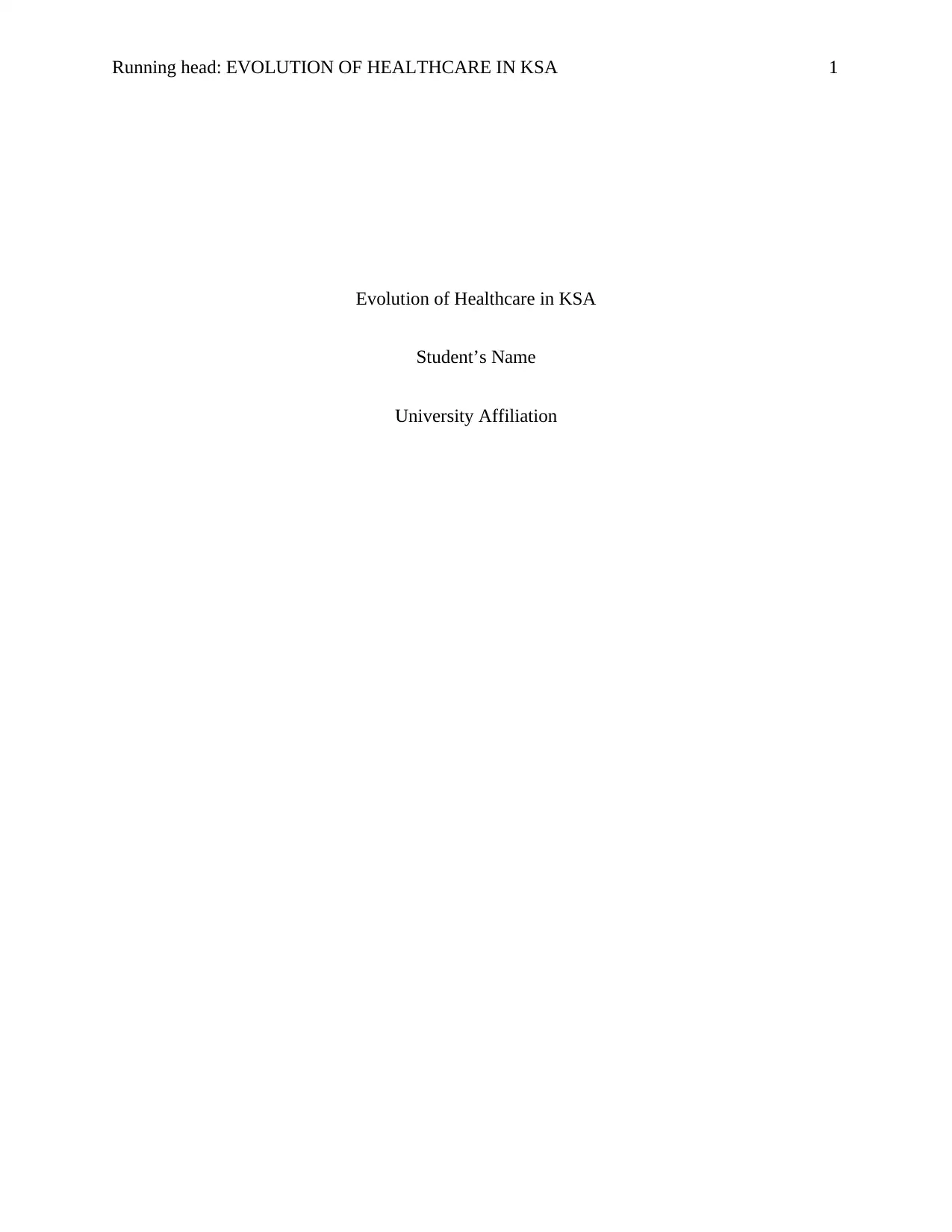
Running head: EVOLUTION OF HEALTHCARE IN KSA 1
Evolution of Healthcare in KSA
Student’s Name
University Affiliation
Evolution of Healthcare in KSA
Student’s Name
University Affiliation
Paraphrase This Document
Need a fresh take? Get an instant paraphrase of this document with our AI Paraphraser
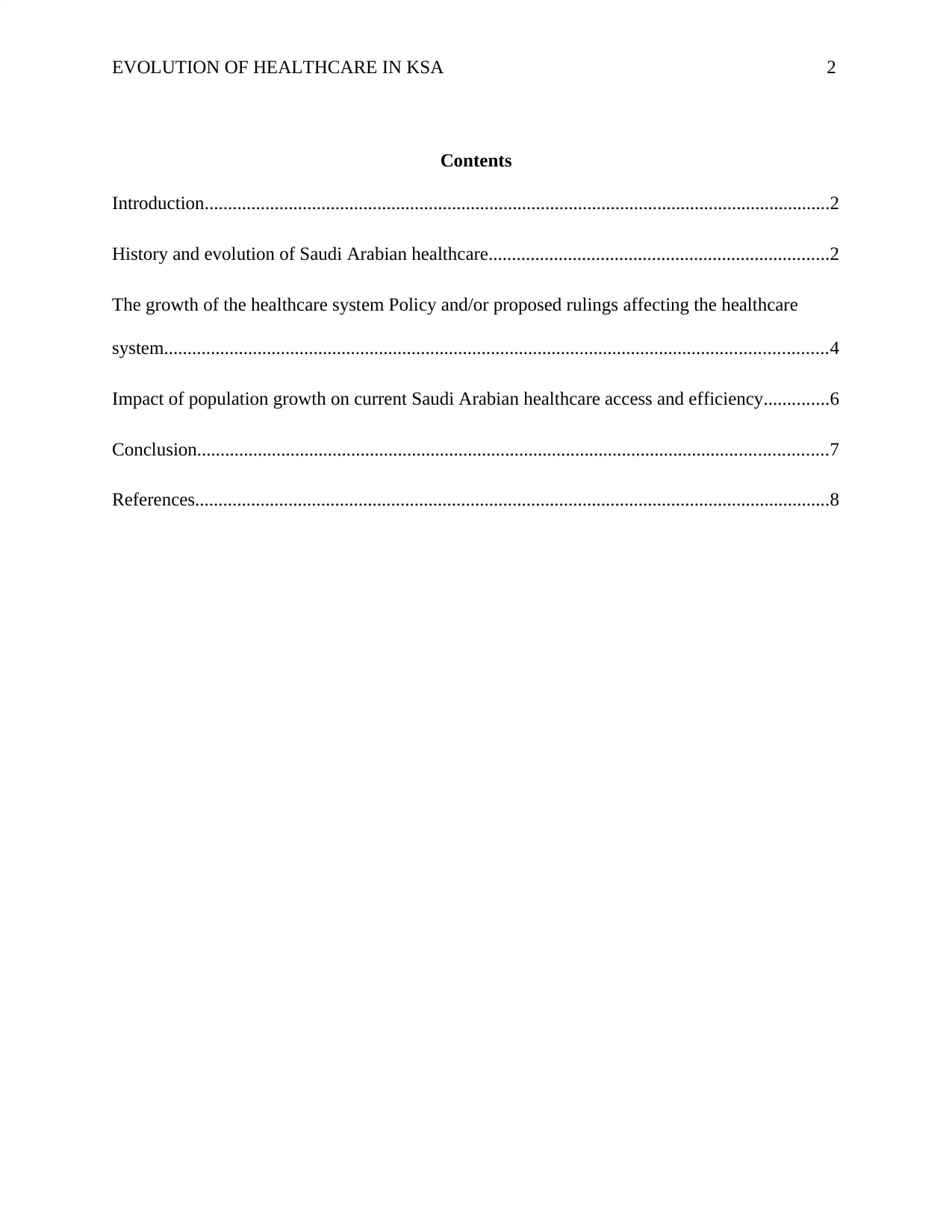
EVOLUTION OF HEALTHCARE IN KSA 2
Contents
Introduction......................................................................................................................................2
History and evolution of Saudi Arabian healthcare.........................................................................2
The growth of the healthcare system Policy and/or proposed rulings affecting the healthcare
system..............................................................................................................................................4
Impact of population growth on current Saudi Arabian healthcare access and efficiency..............6
Conclusion.......................................................................................................................................7
References........................................................................................................................................8
Contents
Introduction......................................................................................................................................2
History and evolution of Saudi Arabian healthcare.........................................................................2
The growth of the healthcare system Policy and/or proposed rulings affecting the healthcare
system..............................................................................................................................................4
Impact of population growth on current Saudi Arabian healthcare access and efficiency..............6
Conclusion.......................................................................................................................................7
References........................................................................................................................................8
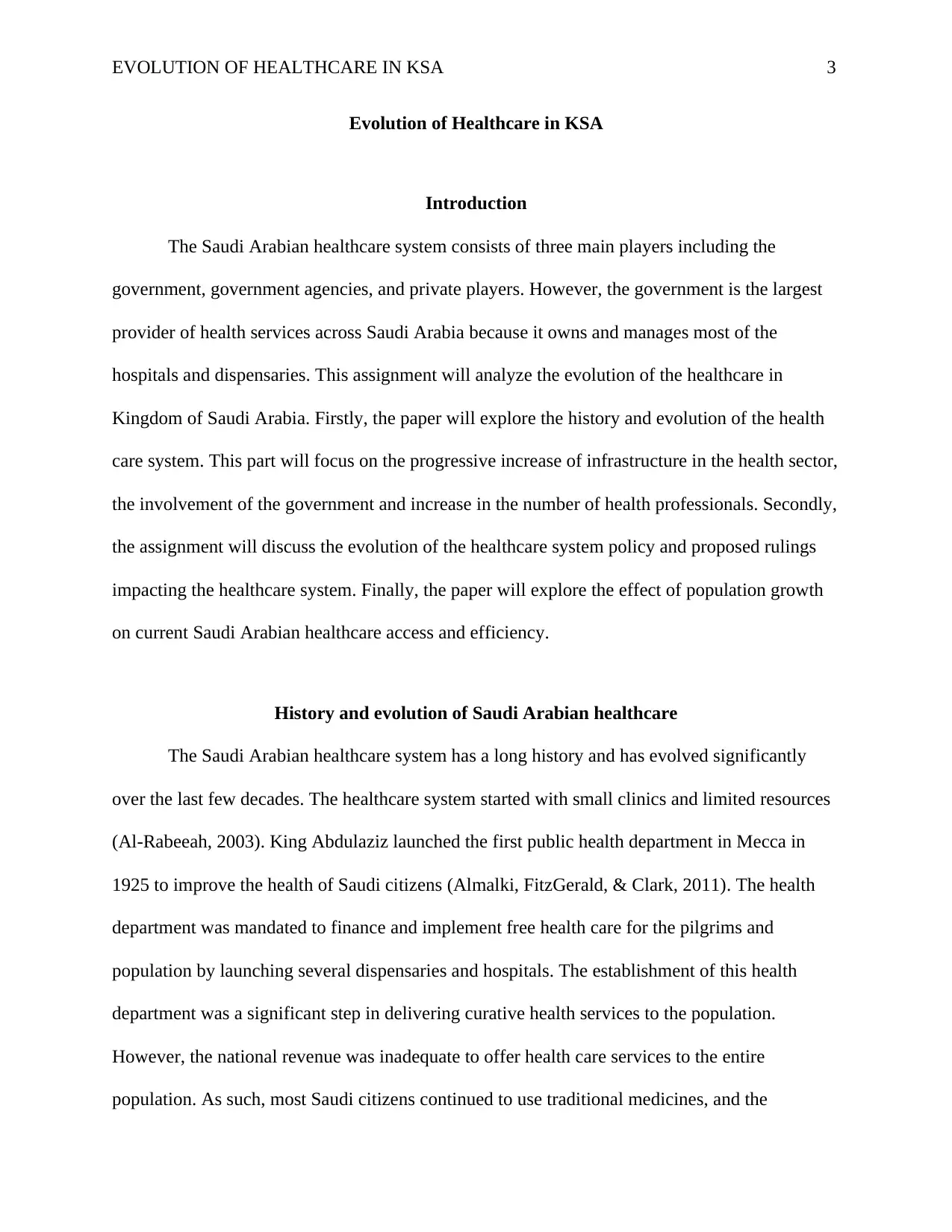
EVOLUTION OF HEALTHCARE IN KSA 3
Evolution of Healthcare in KSA
Introduction
The Saudi Arabian healthcare system consists of three main players including the
government, government agencies, and private players. However, the government is the largest
provider of health services across Saudi Arabia because it owns and manages most of the
hospitals and dispensaries. This assignment will analyze the evolution of the healthcare in
Kingdom of Saudi Arabia. Firstly, the paper will explore the history and evolution of the health
care system. This part will focus on the progressive increase of infrastructure in the health sector,
the involvement of the government and increase in the number of health professionals. Secondly,
the assignment will discuss the evolution of the healthcare system policy and proposed rulings
impacting the healthcare system. Finally, the paper will explore the effect of population growth
on current Saudi Arabian healthcare access and efficiency.
History and evolution of Saudi Arabian healthcare
The Saudi Arabian healthcare system has a long history and has evolved significantly
over the last few decades. The healthcare system started with small clinics and limited resources
(Al-Rabeeah, 2003). King Abdulaziz launched the first public health department in Mecca in
1925 to improve the health of Saudi citizens (Almalki, FitzGerald, & Clark, 2011). The health
department was mandated to finance and implement free health care for the pilgrims and
population by launching several dispensaries and hospitals. The establishment of this health
department was a significant step in delivering curative health services to the population.
However, the national revenue was inadequate to offer health care services to the entire
population. As such, most Saudi citizens continued to use traditional medicines, and the
Evolution of Healthcare in KSA
Introduction
The Saudi Arabian healthcare system consists of three main players including the
government, government agencies, and private players. However, the government is the largest
provider of health services across Saudi Arabia because it owns and manages most of the
hospitals and dispensaries. This assignment will analyze the evolution of the healthcare in
Kingdom of Saudi Arabia. Firstly, the paper will explore the history and evolution of the health
care system. This part will focus on the progressive increase of infrastructure in the health sector,
the involvement of the government and increase in the number of health professionals. Secondly,
the assignment will discuss the evolution of the healthcare system policy and proposed rulings
impacting the healthcare system. Finally, the paper will explore the effect of population growth
on current Saudi Arabian healthcare access and efficiency.
History and evolution of Saudi Arabian healthcare
The Saudi Arabian healthcare system has a long history and has evolved significantly
over the last few decades. The healthcare system started with small clinics and limited resources
(Al-Rabeeah, 2003). King Abdulaziz launched the first public health department in Mecca in
1925 to improve the health of Saudi citizens (Almalki, FitzGerald, & Clark, 2011). The health
department was mandated to finance and implement free health care for the pilgrims and
population by launching several dispensaries and hospitals. The establishment of this health
department was a significant step in delivering curative health services to the population.
However, the national revenue was inadequate to offer health care services to the entire
population. As such, most Saudi citizens continued to use traditional medicines, and the
⊘ This is a preview!⊘
Do you want full access?
Subscribe today to unlock all pages.

Trusted by 1+ million students worldwide
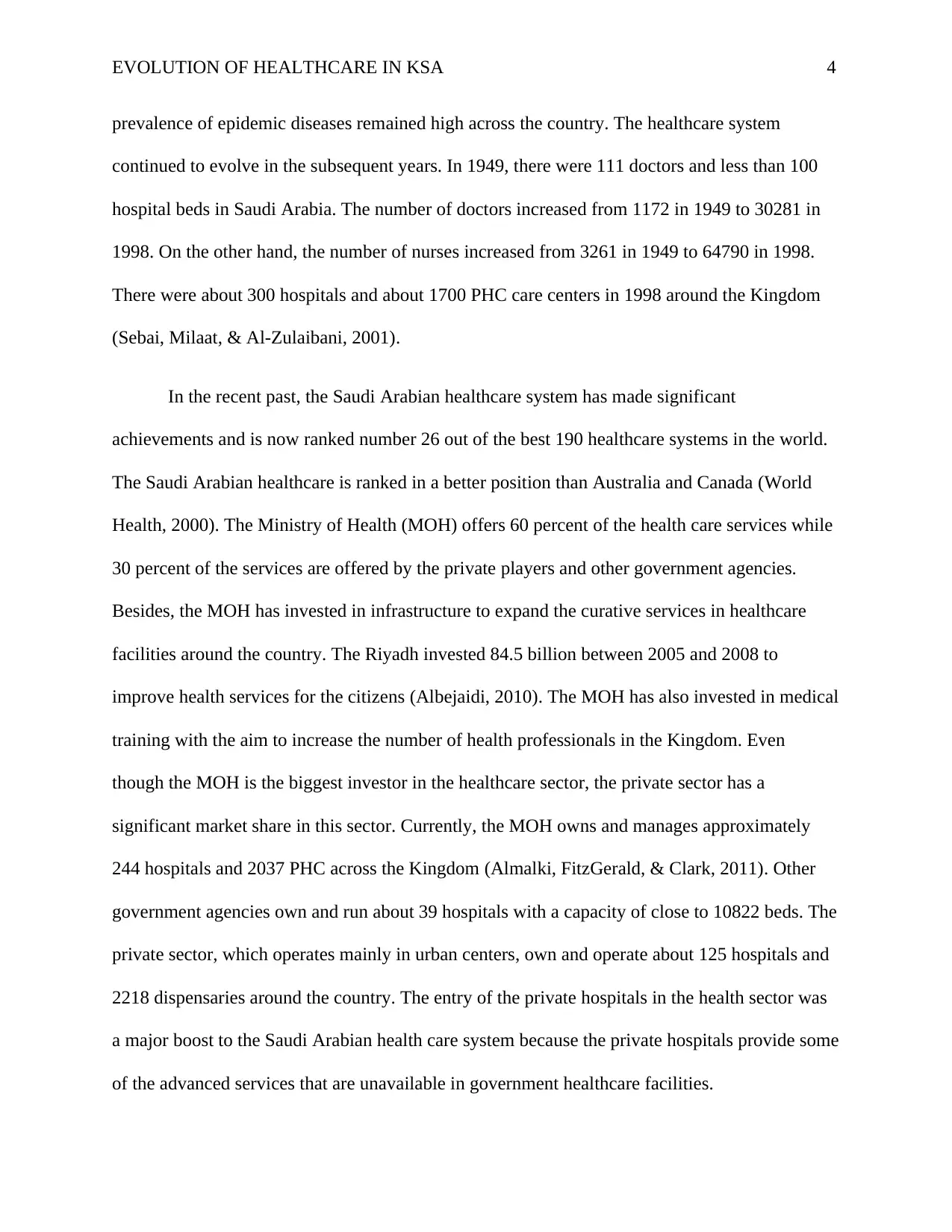
EVOLUTION OF HEALTHCARE IN KSA 4
prevalence of epidemic diseases remained high across the country. The healthcare system
continued to evolve in the subsequent years. In 1949, there were 111 doctors and less than 100
hospital beds in Saudi Arabia. The number of doctors increased from 1172 in 1949 to 30281 in
1998. On the other hand, the number of nurses increased from 3261 in 1949 to 64790 in 1998.
There were about 300 hospitals and about 1700 PHC care centers in 1998 around the Kingdom
(Sebai, Milaat, & Al-Zulaibani, 2001).
In the recent past, the Saudi Arabian healthcare system has made significant
achievements and is now ranked number 26 out of the best 190 healthcare systems in the world.
The Saudi Arabian healthcare is ranked in a better position than Australia and Canada (World
Health, 2000). The Ministry of Health (MOH) offers 60 percent of the health care services while
30 percent of the services are offered by the private players and other government agencies.
Besides, the MOH has invested in infrastructure to expand the curative services in healthcare
facilities around the country. The Riyadh invested 84.5 billion between 2005 and 2008 to
improve health services for the citizens (Albejaidi, 2010). The MOH has also invested in medical
training with the aim to increase the number of health professionals in the Kingdom. Even
though the MOH is the biggest investor in the healthcare sector, the private sector has a
significant market share in this sector. Currently, the MOH owns and manages approximately
244 hospitals and 2037 PHC across the Kingdom (Almalki, FitzGerald, & Clark, 2011). Other
government agencies own and run about 39 hospitals with a capacity of close to 10822 beds. The
private sector, which operates mainly in urban centers, own and operate about 125 hospitals and
2218 dispensaries around the country. The entry of the private hospitals in the health sector was
a major boost to the Saudi Arabian health care system because the private hospitals provide some
of the advanced services that are unavailable in government healthcare facilities.
prevalence of epidemic diseases remained high across the country. The healthcare system
continued to evolve in the subsequent years. In 1949, there were 111 doctors and less than 100
hospital beds in Saudi Arabia. The number of doctors increased from 1172 in 1949 to 30281 in
1998. On the other hand, the number of nurses increased from 3261 in 1949 to 64790 in 1998.
There were about 300 hospitals and about 1700 PHC care centers in 1998 around the Kingdom
(Sebai, Milaat, & Al-Zulaibani, 2001).
In the recent past, the Saudi Arabian healthcare system has made significant
achievements and is now ranked number 26 out of the best 190 healthcare systems in the world.
The Saudi Arabian healthcare is ranked in a better position than Australia and Canada (World
Health, 2000). The Ministry of Health (MOH) offers 60 percent of the health care services while
30 percent of the services are offered by the private players and other government agencies.
Besides, the MOH has invested in infrastructure to expand the curative services in healthcare
facilities around the country. The Riyadh invested 84.5 billion between 2005 and 2008 to
improve health services for the citizens (Albejaidi, 2010). The MOH has also invested in medical
training with the aim to increase the number of health professionals in the Kingdom. Even
though the MOH is the biggest investor in the healthcare sector, the private sector has a
significant market share in this sector. Currently, the MOH owns and manages approximately
244 hospitals and 2037 PHC across the Kingdom (Almalki, FitzGerald, & Clark, 2011). Other
government agencies own and run about 39 hospitals with a capacity of close to 10822 beds. The
private sector, which operates mainly in urban centers, own and operate about 125 hospitals and
2218 dispensaries around the country. The entry of the private hospitals in the health sector was
a major boost to the Saudi Arabian health care system because the private hospitals provide some
of the advanced services that are unavailable in government healthcare facilities.
Paraphrase This Document
Need a fresh take? Get an instant paraphrase of this document with our AI Paraphraser
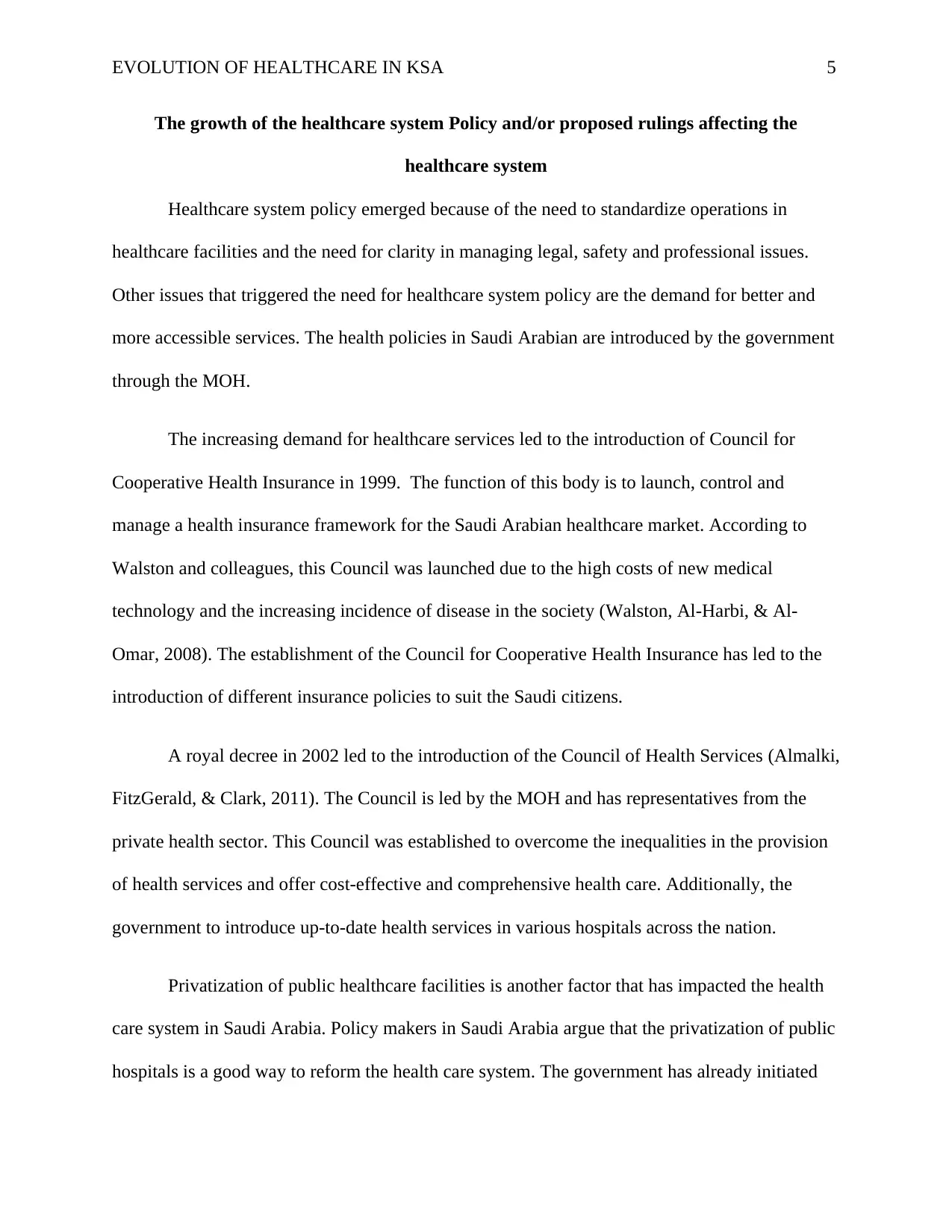
EVOLUTION OF HEALTHCARE IN KSA 5
The growth of the healthcare system Policy and/or proposed rulings affecting the
healthcare system
Healthcare system policy emerged because of the need to standardize operations in
healthcare facilities and the need for clarity in managing legal, safety and professional issues.
Other issues that triggered the need for healthcare system policy are the demand for better and
more accessible services. The health policies in Saudi Arabian are introduced by the government
through the MOH.
The increasing demand for healthcare services led to the introduction of Council for
Cooperative Health Insurance in 1999. The function of this body is to launch, control and
manage a health insurance framework for the Saudi Arabian healthcare market. According to
Walston and colleagues, this Council was launched due to the high costs of new medical
technology and the increasing incidence of disease in the society (Walston, Al-Harbi, & Al-
Omar, 2008). The establishment of the Council for Cooperative Health Insurance has led to the
introduction of different insurance policies to suit the Saudi citizens.
A royal decree in 2002 led to the introduction of the Council of Health Services (Almalki,
FitzGerald, & Clark, 2011). The Council is led by the MOH and has representatives from the
private health sector. This Council was established to overcome the inequalities in the provision
of health services and offer cost-effective and comprehensive health care. Additionally, the
government to introduce up-to-date health services in various hospitals across the nation.
Privatization of public healthcare facilities is another factor that has impacted the health
care system in Saudi Arabia. Policy makers in Saudi Arabia argue that the privatization of public
hospitals is a good way to reform the health care system. The government has already initiated
The growth of the healthcare system Policy and/or proposed rulings affecting the
healthcare system
Healthcare system policy emerged because of the need to standardize operations in
healthcare facilities and the need for clarity in managing legal, safety and professional issues.
Other issues that triggered the need for healthcare system policy are the demand for better and
more accessible services. The health policies in Saudi Arabian are introduced by the government
through the MOH.
The increasing demand for healthcare services led to the introduction of Council for
Cooperative Health Insurance in 1999. The function of this body is to launch, control and
manage a health insurance framework for the Saudi Arabian healthcare market. According to
Walston and colleagues, this Council was launched due to the high costs of new medical
technology and the increasing incidence of disease in the society (Walston, Al-Harbi, & Al-
Omar, 2008). The establishment of the Council for Cooperative Health Insurance has led to the
introduction of different insurance policies to suit the Saudi citizens.
A royal decree in 2002 led to the introduction of the Council of Health Services (Almalki,
FitzGerald, & Clark, 2011). The Council is led by the MOH and has representatives from the
private health sector. This Council was established to overcome the inequalities in the provision
of health services and offer cost-effective and comprehensive health care. Additionally, the
government to introduce up-to-date health services in various hospitals across the nation.
Privatization of public healthcare facilities is another factor that has impacted the health
care system in Saudi Arabia. Policy makers in Saudi Arabia argue that the privatization of public
hospitals is a good way to reform the health care system. The government has already initiated
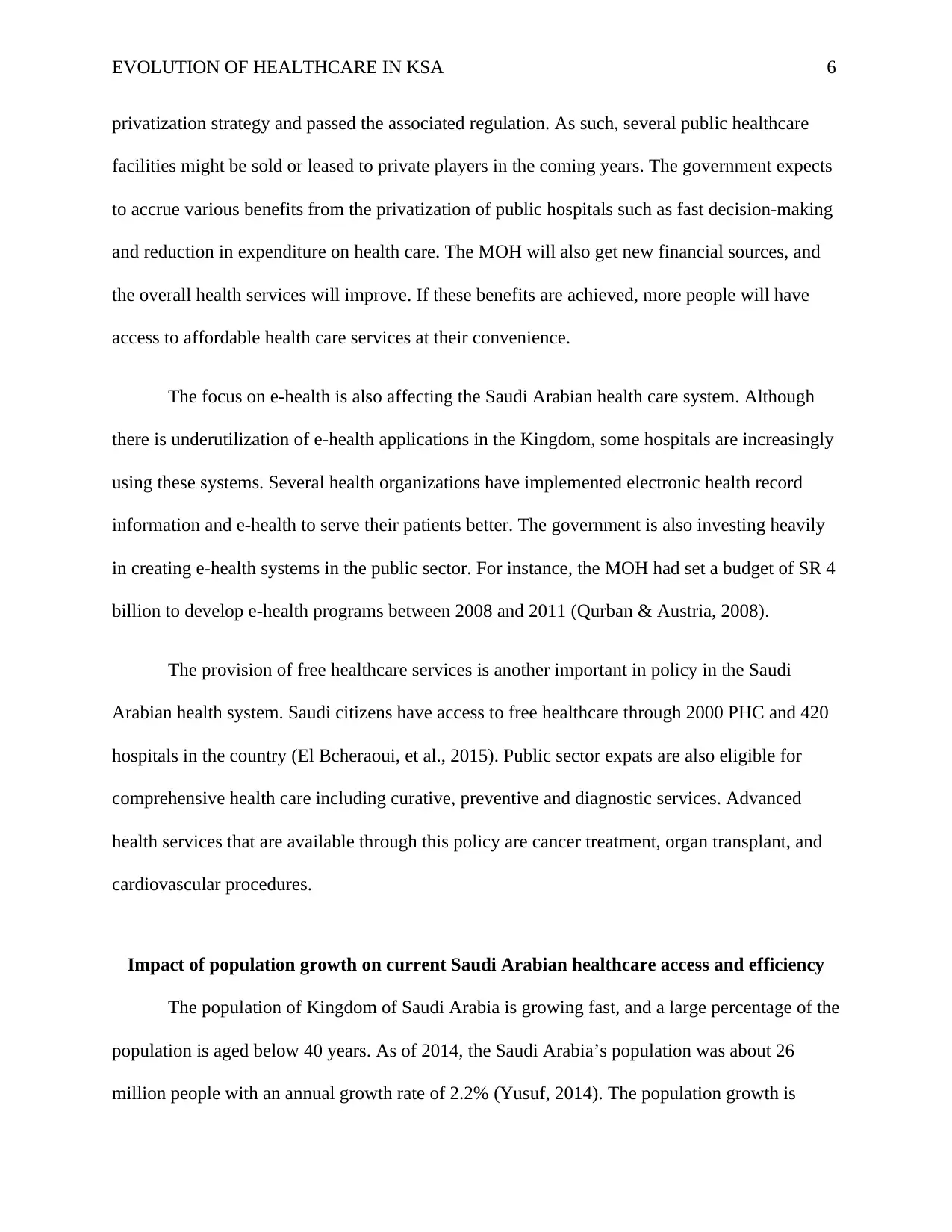
EVOLUTION OF HEALTHCARE IN KSA 6
privatization strategy and passed the associated regulation. As such, several public healthcare
facilities might be sold or leased to private players in the coming years. The government expects
to accrue various benefits from the privatization of public hospitals such as fast decision-making
and reduction in expenditure on health care. The MOH will also get new financial sources, and
the overall health services will improve. If these benefits are achieved, more people will have
access to affordable health care services at their convenience.
The focus on e-health is also affecting the Saudi Arabian health care system. Although
there is underutilization of e-health applications in the Kingdom, some hospitals are increasingly
using these systems. Several health organizations have implemented electronic health record
information and e-health to serve their patients better. The government is also investing heavily
in creating e-health systems in the public sector. For instance, the MOH had set a budget of SR 4
billion to develop e-health programs between 2008 and 2011 (Qurban & Austria, 2008).
The provision of free healthcare services is another important in policy in the Saudi
Arabian health system. Saudi citizens have access to free healthcare through 2000 PHC and 420
hospitals in the country (El Bcheraoui, et al., 2015). Public sector expats are also eligible for
comprehensive health care including curative, preventive and diagnostic services. Advanced
health services that are available through this policy are cancer treatment, organ transplant, and
cardiovascular procedures.
Impact of population growth on current Saudi Arabian healthcare access and efficiency
The population of Kingdom of Saudi Arabia is growing fast, and a large percentage of the
population is aged below 40 years. As of 2014, the Saudi Arabia’s population was about 26
million people with an annual growth rate of 2.2% (Yusuf, 2014). The population growth is
privatization strategy and passed the associated regulation. As such, several public healthcare
facilities might be sold or leased to private players in the coming years. The government expects
to accrue various benefits from the privatization of public hospitals such as fast decision-making
and reduction in expenditure on health care. The MOH will also get new financial sources, and
the overall health services will improve. If these benefits are achieved, more people will have
access to affordable health care services at their convenience.
The focus on e-health is also affecting the Saudi Arabian health care system. Although
there is underutilization of e-health applications in the Kingdom, some hospitals are increasingly
using these systems. Several health organizations have implemented electronic health record
information and e-health to serve their patients better. The government is also investing heavily
in creating e-health systems in the public sector. For instance, the MOH had set a budget of SR 4
billion to develop e-health programs between 2008 and 2011 (Qurban & Austria, 2008).
The provision of free healthcare services is another important in policy in the Saudi
Arabian health system. Saudi citizens have access to free healthcare through 2000 PHC and 420
hospitals in the country (El Bcheraoui, et al., 2015). Public sector expats are also eligible for
comprehensive health care including curative, preventive and diagnostic services. Advanced
health services that are available through this policy are cancer treatment, organ transplant, and
cardiovascular procedures.
Impact of population growth on current Saudi Arabian healthcare access and efficiency
The population of Kingdom of Saudi Arabia is growing fast, and a large percentage of the
population is aged below 40 years. As of 2014, the Saudi Arabia’s population was about 26
million people with an annual growth rate of 2.2% (Yusuf, 2014). The population growth is
⊘ This is a preview!⊘
Do you want full access?
Subscribe today to unlock all pages.

Trusted by 1+ million students worldwide
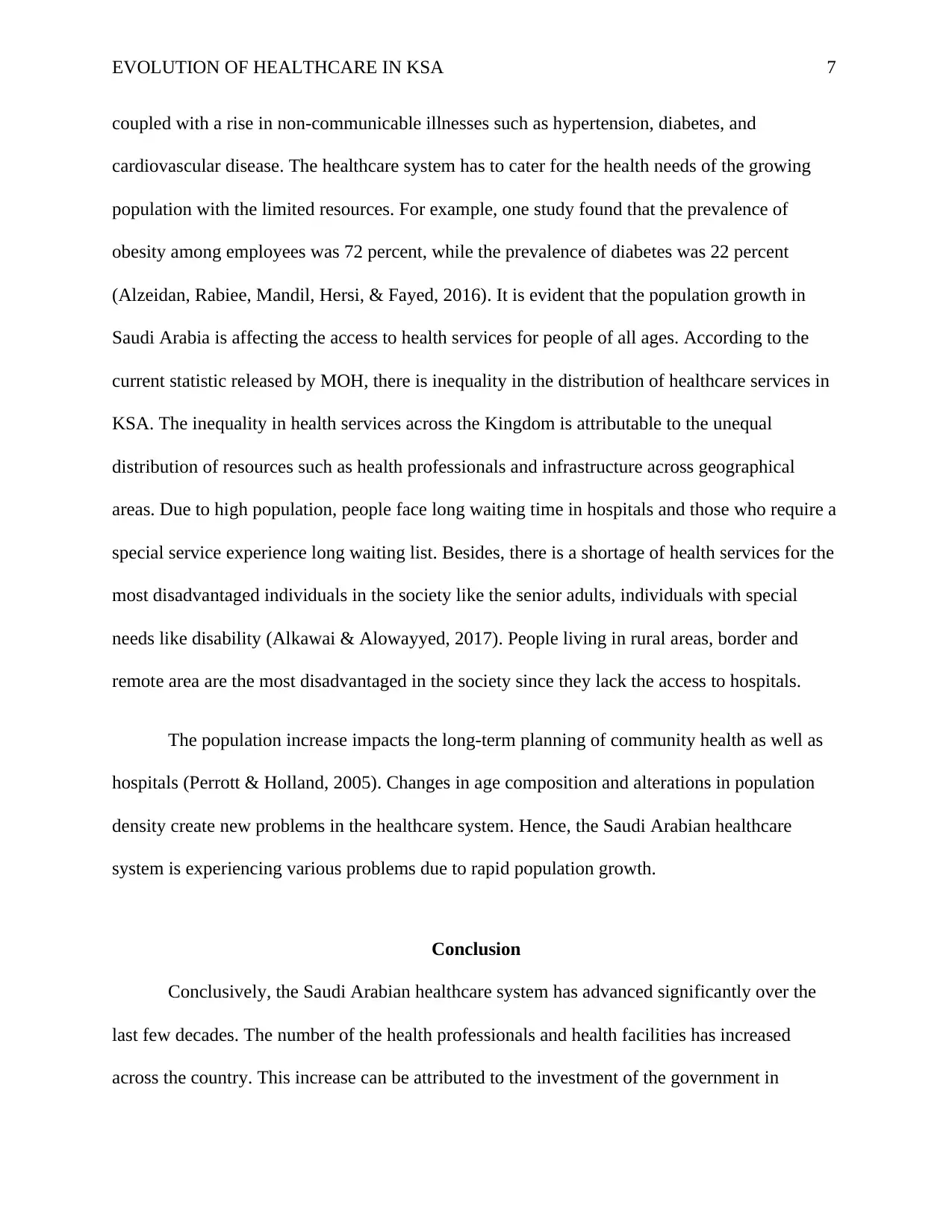
EVOLUTION OF HEALTHCARE IN KSA 7
coupled with a rise in non-communicable illnesses such as hypertension, diabetes, and
cardiovascular disease. The healthcare system has to cater for the health needs of the growing
population with the limited resources. For example, one study found that the prevalence of
obesity among employees was 72 percent, while the prevalence of diabetes was 22 percent
(Alzeidan, Rabiee, Mandil, Hersi, & Fayed, 2016). It is evident that the population growth in
Saudi Arabia is affecting the access to health services for people of all ages. According to the
current statistic released by MOH, there is inequality in the distribution of healthcare services in
KSA. The inequality in health services across the Kingdom is attributable to the unequal
distribution of resources such as health professionals and infrastructure across geographical
areas. Due to high population, people face long waiting time in hospitals and those who require a
special service experience long waiting list. Besides, there is a shortage of health services for the
most disadvantaged individuals in the society like the senior adults, individuals with special
needs like disability (Alkawai & Alowayyed, 2017). People living in rural areas, border and
remote area are the most disadvantaged in the society since they lack the access to hospitals.
The population increase impacts the long-term planning of community health as well as
hospitals (Perrott & Holland, 2005). Changes in age composition and alterations in population
density create new problems in the healthcare system. Hence, the Saudi Arabian healthcare
system is experiencing various problems due to rapid population growth.
Conclusion
Conclusively, the Saudi Arabian healthcare system has advanced significantly over the
last few decades. The number of the health professionals and health facilities has increased
across the country. This increase can be attributed to the investment of the government in
coupled with a rise in non-communicable illnesses such as hypertension, diabetes, and
cardiovascular disease. The healthcare system has to cater for the health needs of the growing
population with the limited resources. For example, one study found that the prevalence of
obesity among employees was 72 percent, while the prevalence of diabetes was 22 percent
(Alzeidan, Rabiee, Mandil, Hersi, & Fayed, 2016). It is evident that the population growth in
Saudi Arabia is affecting the access to health services for people of all ages. According to the
current statistic released by MOH, there is inequality in the distribution of healthcare services in
KSA. The inequality in health services across the Kingdom is attributable to the unequal
distribution of resources such as health professionals and infrastructure across geographical
areas. Due to high population, people face long waiting time in hospitals and those who require a
special service experience long waiting list. Besides, there is a shortage of health services for the
most disadvantaged individuals in the society like the senior adults, individuals with special
needs like disability (Alkawai & Alowayyed, 2017). People living in rural areas, border and
remote area are the most disadvantaged in the society since they lack the access to hospitals.
The population increase impacts the long-term planning of community health as well as
hospitals (Perrott & Holland, 2005). Changes in age composition and alterations in population
density create new problems in the healthcare system. Hence, the Saudi Arabian healthcare
system is experiencing various problems due to rapid population growth.
Conclusion
Conclusively, the Saudi Arabian healthcare system has advanced significantly over the
last few decades. The number of the health professionals and health facilities has increased
across the country. This increase can be attributed to the investment of the government in
Paraphrase This Document
Need a fresh take? Get an instant paraphrase of this document with our AI Paraphraser
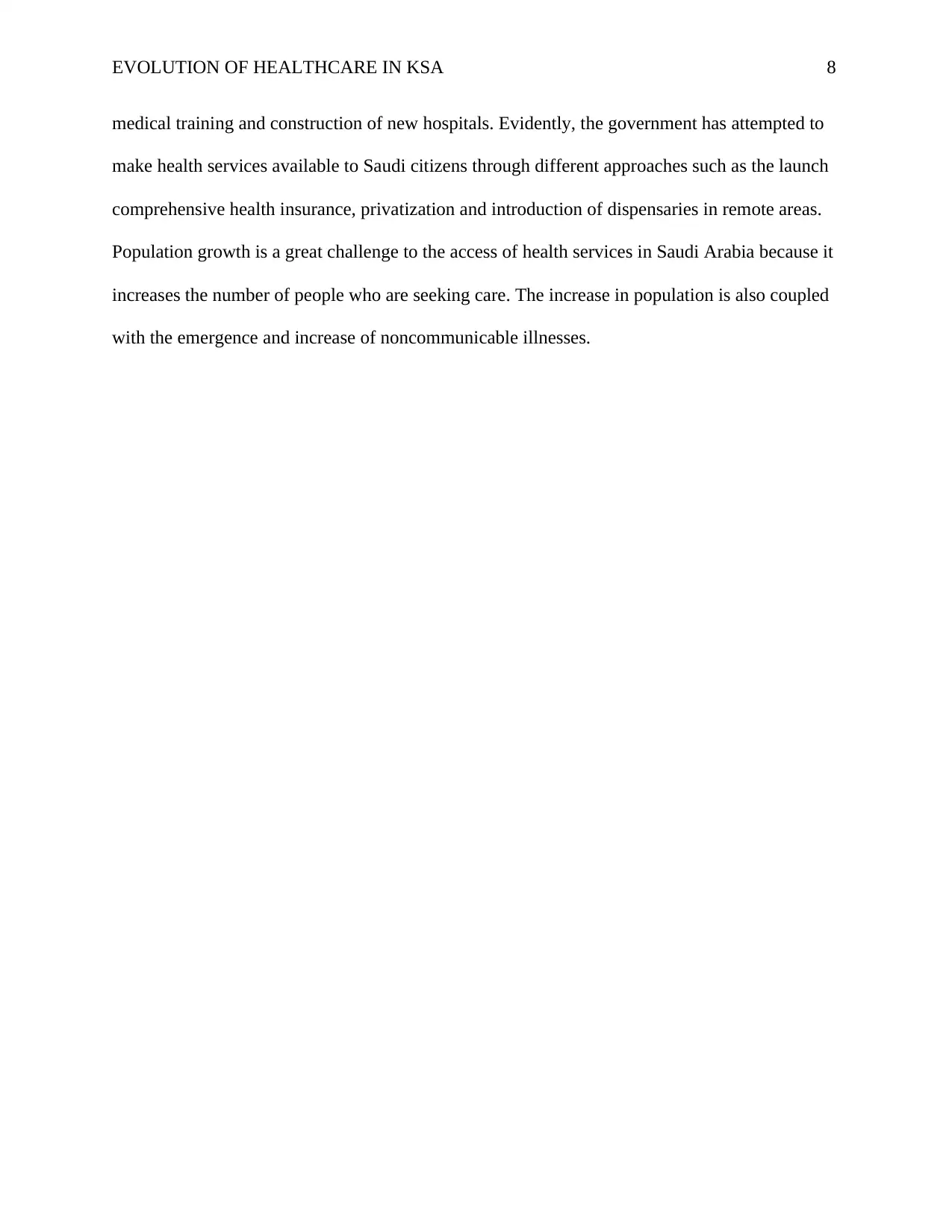
EVOLUTION OF HEALTHCARE IN KSA 8
medical training and construction of new hospitals. Evidently, the government has attempted to
make health services available to Saudi citizens through different approaches such as the launch
comprehensive health insurance, privatization and introduction of dispensaries in remote areas.
Population growth is a great challenge to the access of health services in Saudi Arabia because it
increases the number of people who are seeking care. The increase in population is also coupled
with the emergence and increase of noncommunicable illnesses.
medical training and construction of new hospitals. Evidently, the government has attempted to
make health services available to Saudi citizens through different approaches such as the launch
comprehensive health insurance, privatization and introduction of dispensaries in remote areas.
Population growth is a great challenge to the access of health services in Saudi Arabia because it
increases the number of people who are seeking care. The increase in population is also coupled
with the emergence and increase of noncommunicable illnesses.
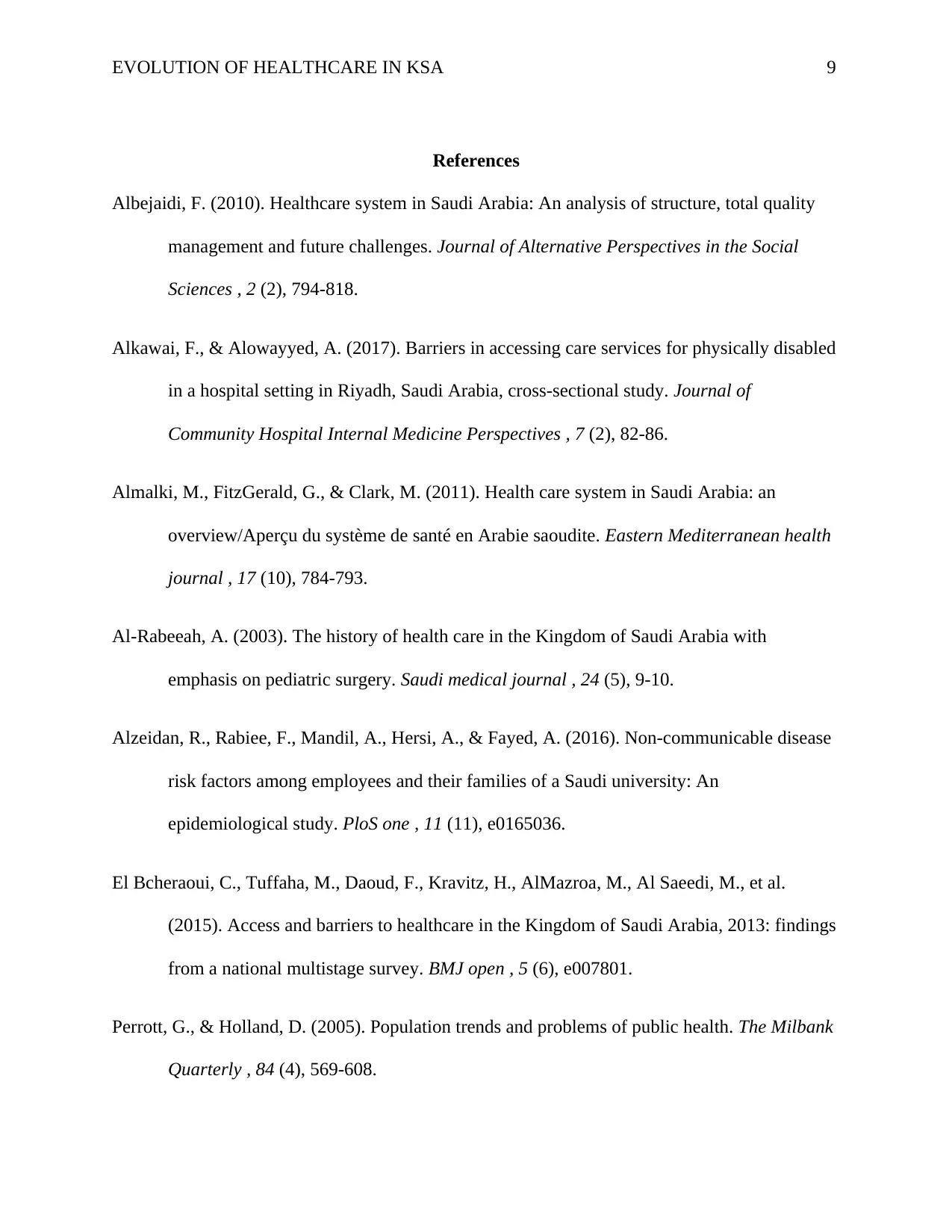
EVOLUTION OF HEALTHCARE IN KSA 9
References
Albejaidi, F. (2010). Healthcare system in Saudi Arabia: An analysis of structure, total quality
management and future challenges. Journal of Alternative Perspectives in the Social
Sciences , 2 (2), 794-818.
Alkawai, F., & Alowayyed, A. (2017). Barriers in accessing care services for physically disabled
in a hospital setting in Riyadh, Saudi Arabia, cross-sectional study. Journal of
Community Hospital Internal Medicine Perspectives , 7 (2), 82-86.
Almalki, M., FitzGerald, G., & Clark, M. (2011). Health care system in Saudi Arabia: an
overview/Aperçu du système de santé en Arabie saoudite. Eastern Mediterranean health
journal , 17 (10), 784-793.
Al-Rabeeah, A. (2003). The history of health care in the Kingdom of Saudi Arabia with
emphasis on pediatric surgery. Saudi medical journal , 24 (5), 9-10.
Alzeidan, R., Rabiee, F., Mandil, A., Hersi, A., & Fayed, A. (2016). Non-communicable disease
risk factors among employees and their families of a Saudi university: An
epidemiological study. PloS one , 11 (11), e0165036.
El Bcheraoui, C., Tuffaha, M., Daoud, F., Kravitz, H., AlMazroa, M., Al Saeedi, M., et al.
(2015). Access and barriers to healthcare in the Kingdom of Saudi Arabia, 2013: findings
from a national multistage survey. BMJ open , 5 (6), e007801.
Perrott, G., & Holland, D. (2005). Population trends and problems of public health. The Milbank
Quarterly , 84 (4), 569-608.
References
Albejaidi, F. (2010). Healthcare system in Saudi Arabia: An analysis of structure, total quality
management and future challenges. Journal of Alternative Perspectives in the Social
Sciences , 2 (2), 794-818.
Alkawai, F., & Alowayyed, A. (2017). Barriers in accessing care services for physically disabled
in a hospital setting in Riyadh, Saudi Arabia, cross-sectional study. Journal of
Community Hospital Internal Medicine Perspectives , 7 (2), 82-86.
Almalki, M., FitzGerald, G., & Clark, M. (2011). Health care system in Saudi Arabia: an
overview/Aperçu du système de santé en Arabie saoudite. Eastern Mediterranean health
journal , 17 (10), 784-793.
Al-Rabeeah, A. (2003). The history of health care in the Kingdom of Saudi Arabia with
emphasis on pediatric surgery. Saudi medical journal , 24 (5), 9-10.
Alzeidan, R., Rabiee, F., Mandil, A., Hersi, A., & Fayed, A. (2016). Non-communicable disease
risk factors among employees and their families of a Saudi university: An
epidemiological study. PloS one , 11 (11), e0165036.
El Bcheraoui, C., Tuffaha, M., Daoud, F., Kravitz, H., AlMazroa, M., Al Saeedi, M., et al.
(2015). Access and barriers to healthcare in the Kingdom of Saudi Arabia, 2013: findings
from a national multistage survey. BMJ open , 5 (6), e007801.
Perrott, G., & Holland, D. (2005). Population trends and problems of public health. The Milbank
Quarterly , 84 (4), 569-608.
⊘ This is a preview!⊘
Do you want full access?
Subscribe today to unlock all pages.

Trusted by 1+ million students worldwide
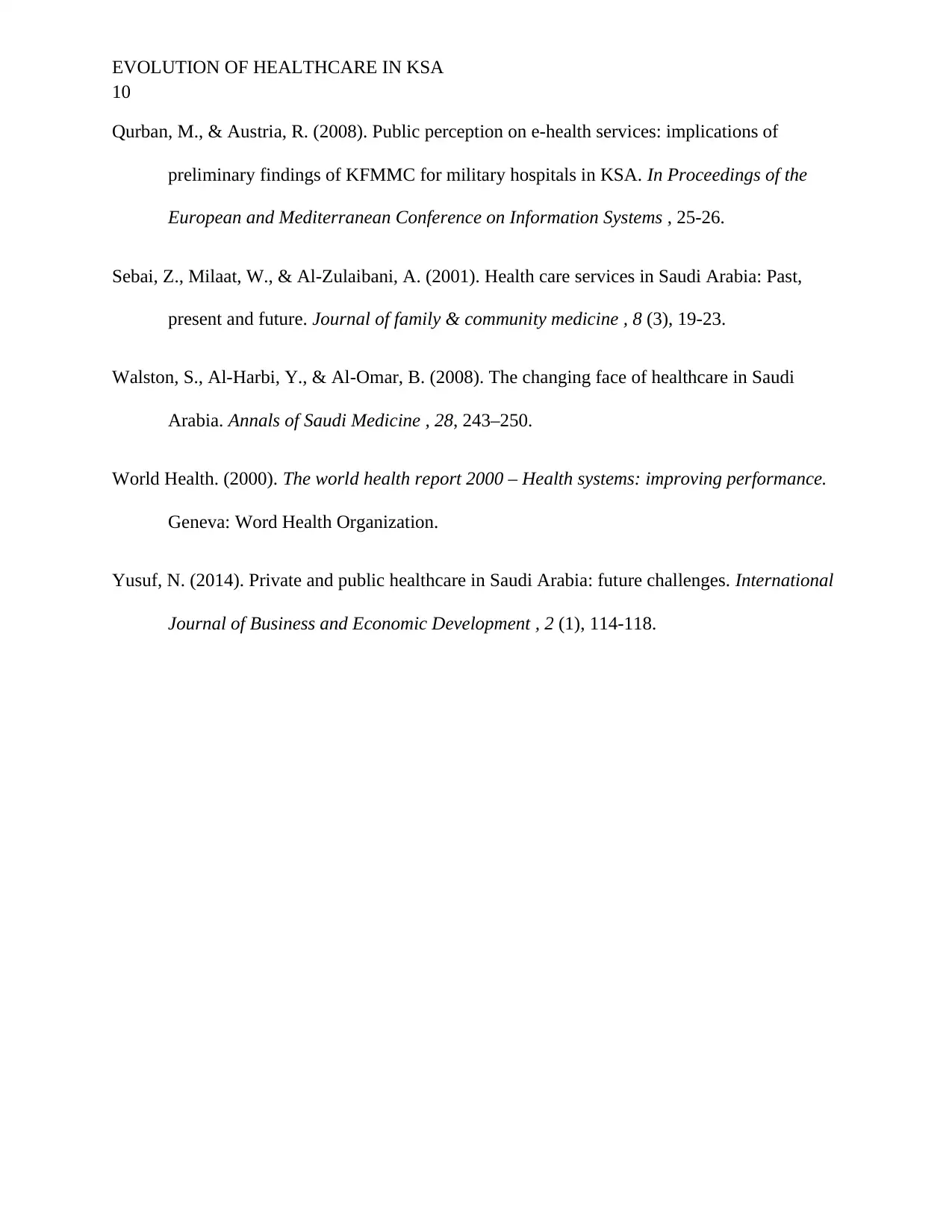
EVOLUTION OF HEALTHCARE IN KSA
10
Qurban, M., & Austria, R. (2008). Public perception on e-health services: implications of
preliminary findings of KFMMC for military hospitals in KSA. In Proceedings of the
European and Mediterranean Conference on Information Systems , 25-26.
Sebai, Z., Milaat, W., & Al-Zulaibani, A. (2001). Health care services in Saudi Arabia: Past,
present and future. Journal of family & community medicine , 8 (3), 19-23.
Walston, S., Al-Harbi, Y., & Al-Omar, B. (2008). The changing face of healthcare in Saudi
Arabia. Annals of Saudi Medicine , 28, 243–250.
World Health. (2000). The world health report 2000 – Health systems: improving performance.
Geneva: Word Health Organization.
Yusuf, N. (2014). Private and public healthcare in Saudi Arabia: future challenges. International
Journal of Business and Economic Development , 2 (1), 114-118.
10
Qurban, M., & Austria, R. (2008). Public perception on e-health services: implications of
preliminary findings of KFMMC for military hospitals in KSA. In Proceedings of the
European and Mediterranean Conference on Information Systems , 25-26.
Sebai, Z., Milaat, W., & Al-Zulaibani, A. (2001). Health care services in Saudi Arabia: Past,
present and future. Journal of family & community medicine , 8 (3), 19-23.
Walston, S., Al-Harbi, Y., & Al-Omar, B. (2008). The changing face of healthcare in Saudi
Arabia. Annals of Saudi Medicine , 28, 243–250.
World Health. (2000). The world health report 2000 – Health systems: improving performance.
Geneva: Word Health Organization.
Yusuf, N. (2014). Private and public healthcare in Saudi Arabia: future challenges. International
Journal of Business and Economic Development , 2 (1), 114-118.
1 out of 10
Related Documents
Your All-in-One AI-Powered Toolkit for Academic Success.
+13062052269
info@desklib.com
Available 24*7 on WhatsApp / Email
![[object Object]](/_next/static/media/star-bottom.7253800d.svg)
Unlock your academic potential
Copyright © 2020–2025 A2Z Services. All Rights Reserved. Developed and managed by ZUCOL.





